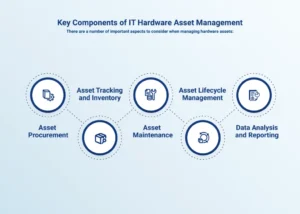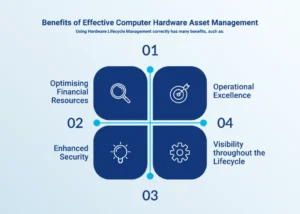Computer Hardware Asset Management Guide
2024-11-22
From servers and laptops to networking gear and IoT devices, companies mostly rely on a spectrum of physical assets in the fast-paced technological scene of today. Maintaining operating efficiency, guaranteeing compliance, and besting costs all depend on effective management of these physical resources. Here is where Hardware Asset Management finds applications.
This guide offers a thorough review of HAM—what it is, why it’s crucial, and how to use asset tracking best practices to properly run the hardware resources of your company.
Understanding Hardware Asset Management
Hardware asset management is the practice of controlling an organization’s physical hardware asset lifecycle. The objective is to maximize value, minimize waste, and guarantee industry compliance by means of optimal purchasing, deployment, maintenance, and ultimate disposal of hardware.
Unlike software asset management (SAM), which emphasizes licensing, deployment, and compliance for software, Hardware Lifecycle Management focusses on the actual assets running the infrastructure of your company. This covers desktop computers, servers, laptops, cellphones, networking gear, even printers, and security cameras.
Types of IT Hardware Assets
In the context of an organization’s technology architecture, IT hardware assets are the actual equipment and components used. Computing, communication, storage, and security all depend on these resources. The following are a few categories of IT hardware assets:
Servers
Servers are designed to manage, store, and analyze data for other devices or users within a network.
Desktops
Desktop computers are stationary computing tools used in workplaces and organizations.
Laptops
Laptops are portable computers used for personal, commercial, and mobile computing.
Key Components of IT Hardware Asset Management
There are a number of important aspects to consider when managing hardware assets:

Asset Procurement
Any Hardware asset management process starts with the procurement stage. This is the time a company buys hardware, either leasing, buying, or sometimes borrowing.
Asset Tracking and Inventory
Once equipment is acquired, it must be tracked and catalogued. Keeping tabs on the quantity, type, location, and state of every asset is made possible with a complete inventory system.
Asset Maintenance
Hardware needs constant upkeep to stay useful. Maintaining an asset well cuts down on downtime and makes it last longer.
Asset Lifecycle Management
Hardware assets only last for a certain amount of time. Because of this, controlling the lifetime of each asset is an important part of Hardware Lifecycle Management to avoid performance issues; this means figuring out when to upgrade things like a laptop or server.
Data Analysis and Reporting
Organizations needing to maximize IT hardware asset management must create reports and apply analytics to assess asset performance. Regular reporting enables cost optimization and assists with decision-making, including asset replacement or retirement decisions.
Benefits of Effective Computer Hardware Asset Management
Using Hardware Lifecycle Management correctly has many benefits, such as:

Optimizing Financial Resources
Good hardware asset tracking and management allows businesses to eliminate unnecessary purchases, reduce downtime, and optimize asset use. This ability of Hardware Asset Management Solutions immediately helps to reduce expenses.
Enhanced Security
Managing hardware assets ensures that outdated or susceptible equipment is replaced or deactivated on time, therefore reducing the risk of cyber-attacks arising from unsupported hardware or software.
Operational Excellence
A well-organized approach to hardware management leads to less downtime, faster troubleshooting, and better help for end users.
Visibility throughout the Lifecycle
From procurement to disposal, complete visibility into the lifecycle of physical assets helps businesses decide wisely on replacements, enhancements, and decommissioning.
Best Practices for Hardware Asset Management
Adopting best practices for Hardware Lifecycle Management can help to guarantee that the assets of your company are correctly tracked, maintained, and utilized. Here are some important techniques:
One-Stop Asset Management
Whether it’s a software application or a neat spreadsheet, all hardware assets should be controlled from one centralized system. This facilitates simple tracking, documentation, and decision-making.
Continual Audits
Regular physical audits of your hardware inventory help to guarantee that system records match the real on-hand count. This habit helps with financial audits and stops theft, loss, or misplacing of valuables.
Asset Visibility & Identification
Whether by QR codes, RFID tags, or barcodes, every piece of hardware should have a tangible tag identifying it. Your asset management system’s digital records should match these distinct IDs.
Put Automation Tools to Work
Wherever you can, use automation. Routine chores, including software updates, maintenance reminders, and reporting, can be automated with tools such as asset management software. This saves time and lessens human error.
Employee Training
Make sure your operations and IT teams have the correct asset management tools and training. Everybody in the company should be aware of their responsibility in handling hardware resources.
Obsolescence Strategy
Technology is changing quickly; technology that was state-of-the-art five years ago might not satisfy present requirements. Set replacement cycles and budgets for upgrading assets to foreshadow hardware obsolescence.
Data Protection and Disposal
When you’re decommissioning equipment, give data security first importance. Verify that the device is disposed of properly and that all data is deleted in line with industry standards.
Conclusion
Modern businesses depending on several physical technology assets must have a proficient familiarity of IT hardware asset management. Following best practices in procurement, inventory control, lifecycle management, and compliance helps companies lower expenses, increase security, and guarantee maximum use of their hardware purchases.
Good Computer Hardware Asset Management Software calls for a methodical approach, a dedication to frequent audits and maintenance, and the use of suitable tools and systems to control assets all through their lifetime. Businesses can maximize the lifetime of their hardware, increase operational efficiency, and reduce risks related to non-compliance and data security breaches by means of correct policies in place.
AntMyERP also helps with services such as AMC management, Warranty management, After-sales Service Management, Return Material Authorization, etc.

